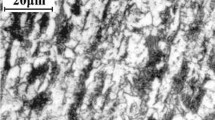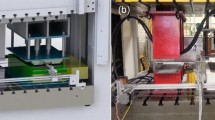Abstract
Due to rising requirements regarding passenger safety and weight reduction hot stamped components get more and more important regarding security relevant parts because of their high strength. Currently, the new challenge is manufacturing components with locally adjusted mechanical properties in order to simultaneously guarantee structural integrity and energy absorption in case of a crash. Therefore, the so called Tailored Tempering process is a promising strategy controlling the cooling rate of the austenitized blank by local heating of the tool and consequently adjusting microstructure development and resulting mechanical properties. As the adjustment of mechanical properties is a temperature dependent process which is also influenced by process parameters and contact conditions, accurate process knowledge is essential. Within this paper the influence of tool temperature and applied contact pressure on the resulting heat transfer coefficient as well as contact condition between the surfaces of former investigations will be shown in a short overview. Based on the results of these fundamental investigations, design principles for Tailored Tempering process will be derived. Furthermore, a hat-profile geometry will be investigated experimentally and characterized by mechanical tests as well as geometrical aspects like sheet thickness and distortion. Additionally, an FE-Modell based on the results of the thermo-mechanical characterization is build up and validated by comparison with the results of experimental work.













Similar content being viewed by others
References
Labudde T, Bleck W (2009) Formability characterisation of press hardened steels. In: Oldenburg M, Steinhoff K, Prakash B (eds) Proceedings of hot sheet metal forming of high performance steel, June 15–17, 2009, Luelå, Sweden. Verlag wissenschaftliche Scripten, Luelå, pp 127–135
Lechler J (2009) Beschreibung und Modellierung des Werkstoffverhaltens von presshärtbaren Bor-Manganstählen. In: Geiger M, Feldmann K (eds) Fertigungstechnik - Erlangen, Bd. 200, Meisenbach, Bamberg
Lenze FJ, Banik J, Sikora S (2008) Applications of hot formed parts for body in white. In: Asnafi N (ed) Proceedings of the IDDRG 2008 Conference, June 16–18, Olofström, Sweden, pp 511–520
Steinhoff K, Maikranz-Valentin M, Weidig U (2007) Bauteile mit maßgeschneiderten Eigenschaften durch neuartige thermomechanische Prozessstrategien in der Warmblechumformung. In: Geiger M, Merklein M (eds) 2. Erlanger Workshop Warmblechumformung, Nov 22, 2007, Erlangen, Germany. Meisenbach, Erlangen, pp 1–12
Merklein M, Lechler J, Stöhr T, Svec T (2010) Herstellung von funktionsoptimierten Bauteilen im Presshärtprozess. In: Stahlinstitut VDeH (ed) Stahl und Eisen, 6, pp 51–57
Feuser P, Schweiker T (2009) Tailored Tempered Parts—Presshärtbauteile mit maßgeschneiderten Eigenschaften. In: Merklein M, Lechler J (eds) 4. Erlanger Workshop Warmblechumformung, Nov 11, 2009, Erlangen, Germany. Meisenbach, Erlangen, pp 127–142
Bardelcik A, Ghavam K, George R, Worswick J (2011) An impact model of a hot stamped lab-scale B-pillar with tailored properties. In: Oldenburg M, Steinhoff K, Prakash B (eds) CHS2 2011, Proceedings of hot sheet metal forming of high-performance steel, June 13–17, 2011, Kassel, Deutschland. Verlag wissenschaftliche Scripten, Auerbach, S. 221–228
Ahrens U (2003) Beanspruchungsabhängiges Umwandlungsverhalten und Umwandlungsplastizität niedrig legierter Stähle mit unterschiedlich hohem Kohlenstoffgehalt. Berlin
Gottstein G (2007) Physikalische Grundlagen der Materialkunde. Berlin. ISBN 978-3-540-71104-9
Merklein M, Svec T (2010) Transformation kinetics of the hot stamping steel 22MnB5 in dependency of the applied deformation on the austenitic microstructure. In: Kolleck R (ed) Proceedings of 50th conference of IDDRG 2010, May 31–June 02, 2010, Graz, Austria. Verlag der technischen Universität Graz, Graz, pp 71–80
Svec T, Merklein M (2010) Auswirkungen spezifischer Abkühlbedingungen auf den Wärmeübergang bei Presshärtprozessen. In: Merklein M (ed) Tagungsband: 5. Erlanger Workshop Warmblechumfor-mung, Dec 8., 2010, Erlangen, Germany. Meisenbach, Bamberg, pp 121–140
Acknowledgments
This work was elaborated in the Transfer Project ME2043/16-1 funded by the German Research Foundation (DFG). The authors thank the DFG for the financial support.
Author information
Authors and Affiliations
Corresponding author
Rights and permissions
About this article
Cite this article
Merklein, M., Svec, T. Hot stamping: manufacturing functional optimized components. Prod. Eng. Res. Devel. 7, 141–151 (2013). https://doi.org/10.1007/s11740-012-0429-z
Received:
Accepted:
Published:
Issue Date:
DOI: https://doi.org/10.1007/s11740-012-0429-z




